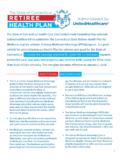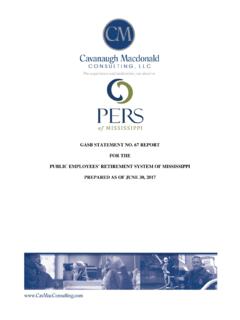Transcription of STATE EMPLOYEES RETIREMENT SYSTEM - osc.ct.gov
1 STATE EMPLOYEES RETIREMENT SYSTEM - DEFINED BENEFIT PLANS - PROCEDURES AND GUIDELINES FOR DETERMINING QUALIFIED STATUS OF A DOMESTIC RELATIONS ORDER I. INTRODUCTION The STATE EMPLOYEES RETIREMENT SYSTEM (SERS) is a governmental RETIREMENT plan and, as such, is exempt under United States Code, Title 29, Section 1003 from the federal requirements of the employee RETIREMENT Income Security Act (ERISA) and the RETIREMENT Equity Act as they pertain to a Qualified Domestic Relations Order ( QDRO ). A QDRO is a domestic relations order (DRO) that provides for payment of benefits from a qualified plan to a spouse, former spouse, child or other dependent of a plan member and that meets certain requirements.
2 As noted, SERS, as a governmental plan is not governed by ERISA. However, the STATE EMPLOYEES RETIREMENT Act does provide for the division of pension benefits when is so ordered by a court of competent jurisdiction in recognition of marital asserts or child support obligations, providing such order is not contrary to SERS plan provisions. This plan approved domestic relations order, referred to as a PADRO in these guidelines for ease of reference, is a court order (DRO) that meets the conditions specified by STATE law and by SERS. Additionally, Conn.
3 Gen. Stat. Sec. 52-321a allows a QDRO to be ordered by a court upon petition by the STATE to recover the costs of incarceration of a plan member or beneficiary or upon the petition of a victim of a crime committed by a member to recover damages awarded by a court of competent jurisdiction. A SERS PADRO is a deemed qualified domestic relations order for purposes of Sec. 52-321a and for federal tax purposes. The STATE EMPLOYEES RETIREMENT Commission is responsible for the proper administration of SERS; therefore, it is imperative that the court, the attorneys, and the parties become familiar with the Commission's requirements and some important SERS plan provisions before executing a pension division order.
4 Copies of the summary plan descriptions for each of the STATE s three plans are available on the Connecticut STATE Comptroller website at modifiable version of the Model PADRO may be downloaded from the same web site. The role of the Commission and of the RETIREMENT and Benefit Services Division in approving PADROs is simply to determine whether the PADRO satisfies the requirements under the Internal Revenue Code and under the Plan. The Division s pre-approval or final approval of the PADRO relates solely to whether the technical requirements for PADROs were satisfied.
5 Whether or not the PADRO is at a stage where the parties should agree to its terms or whether the terms are fair to the parties is not a determination for the Commission or the Division to make. Neither the Commission nor the Division are, or can be, involved in any negotiations between the parties as to the division of RETIREMENT plan benefits. Neither the Commission nor the Division can (or will) give legal or actuarial advice with regard to the terms of the PADRO or the value of the benefit being discussed. II. BASIC PROCEDURAL STEPS FOR PADRO PREPARATION 1.
6 SERS does not write PADROs. SERS reviews draft PADROS to determine if they can be administered. 2. The drafter of the PADRO should find out everything he or she can about the member and his/her benefits. Each member is given a Personal Statement of Benefits in the fall of every year. It is suggested that the drafter obtain a copy of this Statement from the member (SERS does not keep copies) prior to drafting the Order. While the amounts in the Statement are estimates, the Statement does provide important basic information about the member s RETIREMENT benefits including Tier membership, payment options and contribution information.
7 3. The drafter needs to draw up the DRO in accordance with the steps outlined in these guidelines and in conformance with the Model PADRO provided. SERS is not governed by ERISA: language relating to ERISA plans should not be used. It goes without saying, both the Participant and the Alternate Payee should agree on its provisions before it is drafted. 4. SERS will pre-approve a DRO and the drafter should send it to SERS for approval. When the DRO is pre-approved by SERS, then have the parties sign it and submit it to the court for approval.
8 5. When the court approval is obtained, one of the parties must obtain a court certified copy of the court order. This copy should be sent, preferably by certified mail, to SERS for approval as a PADRO. 6. When SERS approves the DRO as a PADRO, it sends out a notice to the parties. Both the participant and the alternate payee (and their attorneys) should keep a copy of both the PADRO and the notice. 7. What happens if SERS doesn t approve it at this end stage? SERS will send you a notice which will include the reasons for the rejection including if applicable, a description of any additional material, information, or modifications necessary for the order to be a PADRO and an explanation of why such material, information, or modifications are necessary.
9 For example, the rejected order may contain a provision for a lump sum distribution of benefits which is not an option offered by SERS. At that time, the drafter will need to return to Step 3 and start the entire process over again. It is important to note that SERS can, and will, reject even a court approved order if it does not conform to plan provisions. 8. Plan accordingly: it can take 4-6 months for DRO approval by the Plan. 9. Three things to keep in mind: A PADRO should not be confused with an alimony award; it is viewed more of a marital asset as opposed to spousal support.
10 2 A PADRO is not always necessary in situations of divorce. If the parties can agree to divide other marital property equitably, then SERS benefits may not need to be divided, and there may not be a need for a PADRO. A SERS PADRO must be a final judgment, decree, or order that has been qualified by SERS. If an order has not been signed by a duly appointed judicial official and filed in accordance with applicable laws and procedures, the order may be a domestic relations order, but it is not an SERS PADRO and it will not be enforced.

















